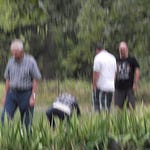When the going gets tough, do the tough take a shortcut? Probably not. Taking a shortcut is not the path to building anything tough or strong. But the temptation of faster, the lure of a shortcut, calls from every direction.
My Mysterious Mind
A peculiar thing happened inside of me after I used ChatGPT to provide content for my previous post on GenAI. With the tab open on my laptop while finishing the post, I felt this unsettling tug to use it again. Like a genie released from its bottle, there was this inaudible whisper of “let me help you do this faster.” Unnerved by the pull, I closed the tab on my browser and breathed a sigh of relief. The temptation of faster was conquered. For the moment, anyway.
However, the temptation to find a shortcut has been inside of me all my life, as I suspect it has been also in you; ChatGPT was merely the most recent means to find a faster way. As a new driver, I dropped one of the rear care tires off the edge of the gravel road when turning the corner out of our lane. I had cut the corner too short and was stuck because of it. In early adulthood, my husband and I were lured into a multilevel marketing scheme that promised a get-rich-quick solution to our financial struggles. Instead of providing a monetary windfall of mailbox money for life, our time in MLM drained our discretionary income and left us with a useless box of motivational cassette tapes.
Then, years later, I was pulled over by a local police officer in a nearby town for rolling a stop sign after a high school football game. That extra second or two saved by not coming to a full and complete stop cost me an embarrassing conversation and a delay to our drive home. Thankfully, it didn’t cost me a ticket, a fine, and points on my license. But those two speeding tickets I got in my twenties did that. The temptation of faster perpetually beckons through the accelerator in my car. And those 325 ponies under the hood do, too. I’ve learned to keep them under control, most of the time.
The temptation of faster is not in the least bit constrained in the world of technology. In fact, the faster technology changes the faster it is able to change. This exponential acceleration of technological change was predicted by Gordon E. Moore in a paper he wrote in 1965. Moore observed that the number of components that could fit on an integrated circuit had doubled every year for six previous years. He predicted 65,000 components on a chip by 1975; the actual number was about 12,000, so the predicted doubling was adjusted to 18 months (see The Clock of the Long Now, 1999, p. 12). This exponential rate of doubling, named Moore’s Law, has continued and, in some cases, has shown doubling in less than 18 months, depending on what aspect of technology is being measured. The computer you hold in your hand, i.e., your smartphone, contains 120 million times the computing power of the computer that sent Apollo 11 to the moon in 1969.
Which makes me wonder. Can a human being appropriately manage the temptation of faster provided by modern technology? What about the shortcuts along the path of a normal, non-technical life? The pull of getting somewhere faster is lurking inside each of us. How do we live a well-managed, meaningful life with shortcuts at every turn, and the temptation of faster enticing us?
Message of Mystery Acres
There is only one clock at Mystery Acres, the one in our motorhome. It runs on a battery and is often wrong. When my husband and I arrive, we bring with us at least three clocks, namely, our cell phones and the clock in the truck. If either of us brings a laptop or tablet, those are additional clocks. Time doesn’t seem to matter much in the forest, and, with it, the temptation of faster doesn’t either.
In fact, life in the forest is delightfully slow. Furthermore, the pace isn’t changing with every visit. Nothing is doubling. No revolutionary technological shift is threatening the stability of our time there. The slowing pace of the journey there is a stark contrast to the pace of the modern world. We travel on a major highway, then a secondary highway, then a private gravel road, and then, finally, onto the gravel path onto our property, moving more slowly with every section of our journey. What a relief it is to leave the rush of modern, techno-driven life, and just exist in nature!
There are shortcuts possible in the forest, but the consequences can be tricky. There is a large loop of road through the area, an interesting, albeit tiring path for a stroll. A shortcut is available but means navigating through poison ivy. When we first owned Mystery Acres, I regularly took random walks through the forest, no matter the undergrowth. After a severe reaction to poison ivy, I have become more cautious when it comes to taking shortcuts.
Also, given the uneven terrain of the forest, sometimes the safest path is not the direct or fastest one. Going back and forth in modified switchbacks is much slower for hiking on the hills, but the risk of mechanical injury is greatly reduced. Better yet, find a game trail, nature’s deer highways, and follow those paths. The undergrowth is less and the circuitous path much safer than just a straight line to where you think you’re going.
The message of Mystery Acres is to look for the slow path and beware of the shortcuts. The temptation to get somewhere faster might mean a fall and consequent injury or a rash of irritated skin. The forest whispers a slower cadence to follow than the ever-accelerating pace of the concrete and asphalt jungle.
Ancient Mystery’s Voice
“The Lord isn’t slow at keeping His promises, as some people think of slowness; He is patient because He doesn’t want anyone to be lost.” (see 2 Peter 3:9)
Does God take shortcuts? When faced with the possibility of accomplishing something faster, does He take the quicker path?
I cannot find any evidence of God choosing the fast route. Instead of Jesus coming to earth as a fully formed adult human, He took the slow way. He could have just shown up at age 30, spent a few years teaching and establishing His presence, chose a fast death, came back to life three days later (that part matches the actual path) and declared victory. Arriving as a zygote in the womb of Mary, He took the typical 9-months until birth, then lived as a helpless infant, dependent child, awkward adolescent, and twenty-something human. Finally, at about age 30, He started His official ministry on earth. Then, three years later, He purposefully traveled into Jerusalem knowing His death would be a slow, horrific one, nailed to a cross. I don’t see any shortcuts in the choices Jesus made, choices that serve as an example to the rest of us (except, I hope, the version of death!).
Zooming out, we see the Lord writing His story of redemption of humans right after the fall of Adam and Eve, depicted in Genesis. “Don’t worry,” He said (and I paraphrase), “I know you screwed up big-time, but I’ll fix it by sending a savior. I promise.” When Eve gave birth a few Bible verses later, she thought she’d given birth to that savior. Wrong. The actual savior would show up about four thousand years later. That seems like a very slow fulfillment of a promise!
Then, after Jesus’ ministry on earth, He promised to come back. The disciples watched for His return with eagerness. Two thousand years later, the followers of Jesus are still waiting. Another really slow delivery of a promise is happening now. Like the impatient children in the backseat on a long car ride, we whine, “How much longer is it?”
Peter wrote that the Lord isn’t slow in keeping His promises, unless you use the human view of slowness. There is a method to His dawdling, a reason for His refusal to take any shortcuts. God wants as many people as possible to become a permanent part of His family, not lost to the dusts of time. God could have shortened the timeline, but He chose not to.
The voice of Ancient Mystery invites us to consider our lives from a much longer, and slower, perspective. When faced with a fork in the road, with one route offering a shortcut, and the other a long, slow journey, Ancient Mystery says to go the slow way. That’s the way our Creator chooses. The Lord is not slow as people view slowness. He wants thousands of years to pass so the maximum number of His children can be saved into His family.
Living in Mystery
What does it mean to live in the mystery of shortcuts, understanding the temptation of faster? First, it means recognizing the persistent temptation of a faster way to whatever we want. Like little children still learning self-control, we want what we want when we want it, and not any longer than absolutely necessary. All grown-up, we’ve learned not to throw temper tantrums when what we want is delayed or denied, but the longing for immediate gratification remains. For me, that longing was reawakened by my tiny bit of ChatGPT. Even though I closed the tab, there’s something in me that is different now. And I don’t like it.
Second, this mystery implores each of us to recognize the dangers of shortcuts. For most of civilization, wisdom has called for “slow down, you might break something.” Mark Zuckerberg, popular for creating Facebook, encouraged his company software developers to “move fast and break things.” This motto, though successful in building a social media empire, is also a driving factor in the problematic monopolies that destroyed the decentralized vision of the Internet, as described by Jonathan Taplin in his book, Move Fast and Break Things: How Facebook, Google, and Amazon Cornered Culture and Undermined Democracy. Taking the reckless, fastest path has created Internet giants causing problems for the fabric of our civilization.
But I am not calling on you to fix the Internet. Mystery’s Voice, my voice, is asserting the supreme value of going slowly and carefully. There are no shortcuts to excellence or expertise. Building something that matters takes a considerable amount of time. Fast construction products create inferior structures to those governed by systematic, and slow, attention to detail. When given a choice between a shortcut and the traditional, slow path, the latter is probably better, though slower.
As an old mom to young parents, please teach your children the value of taking time to do things well. With an abundance of techno-shortcuts available, and the number growing rapidly, this is a challenging value to instill in our modern young. Model for them the value of slow work, avoiding shortcuts for your own success. Tell them to slow down and do things well. Haste makes waste. These old-fashioned virtues are needed now more than ever.
Beware the temptation of the shorter, faster way to what you want. If success were convenient and fast, everyone would be successful. Quality outcomes require large amounts of time and effort. Moving too quickly will break things. It’s wise to move slowly and carefully. Ponder the timeline of the forest and the example of its Creator. It’s OK, take your time.
Connecting with Mystery
Dear Lord of All Mystery, I confess to being tempted to find a faster way to what I want, despite the patient example You have provided me. Help me to recognize when the temptation to choose a shortcut calls to me; strengthen me to choose the slow, better way. Thank You for being slow, not as I understand slowness, but a beautiful patience that allows more of us to become a part of Your family of love. Amen.
Notes from Dr. Mac
If you want to do your own investigation of any of the scriptures I use, I suggest you go to Bible Gateway. This free online version of the Bible allows a search of words or phrases in various translations. I encourage you to meditate on second Peter, chapter three, verse nine and consider what God’s version of slowness might look in your life.
Do you want more from my writing? I have over two years of previous posts, which you can find at my ARCHIVE. I also have topically organized compilations of my previous work in the My Books section. And Mystery’s Voice is on Spotify.
Do you know someone who might enjoy receiving Mystery’s Voice? You can subscribe a friend or family member for free by adding an email address to my mailing list via the Subscribe button below.
I want to know what you’re thinking! You can email me at: Dear Dr. Mac or leave/send a message (see below). I love hearing from you!














Share this post